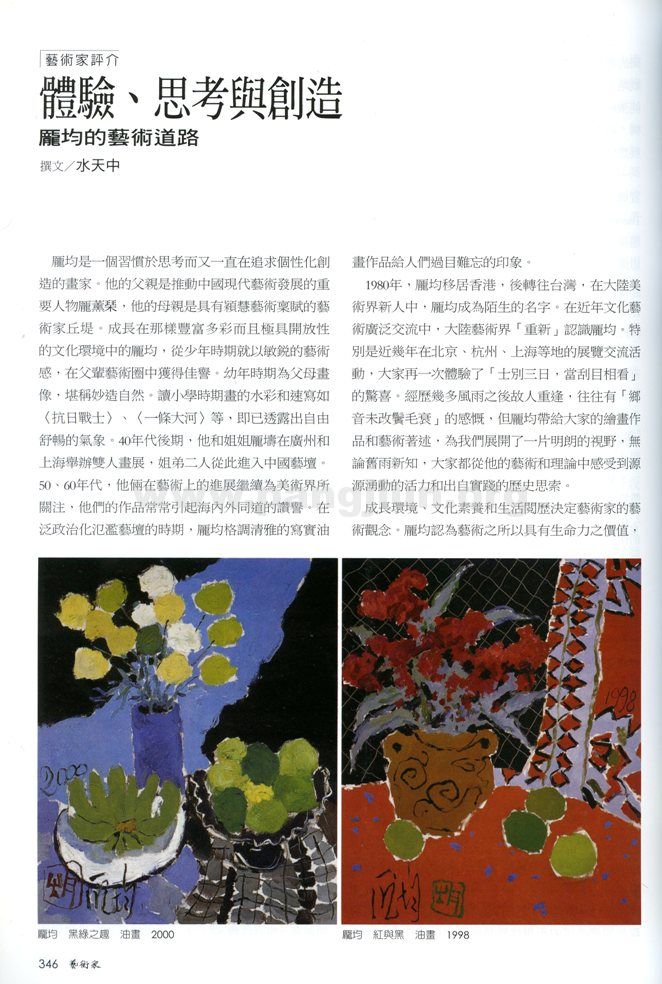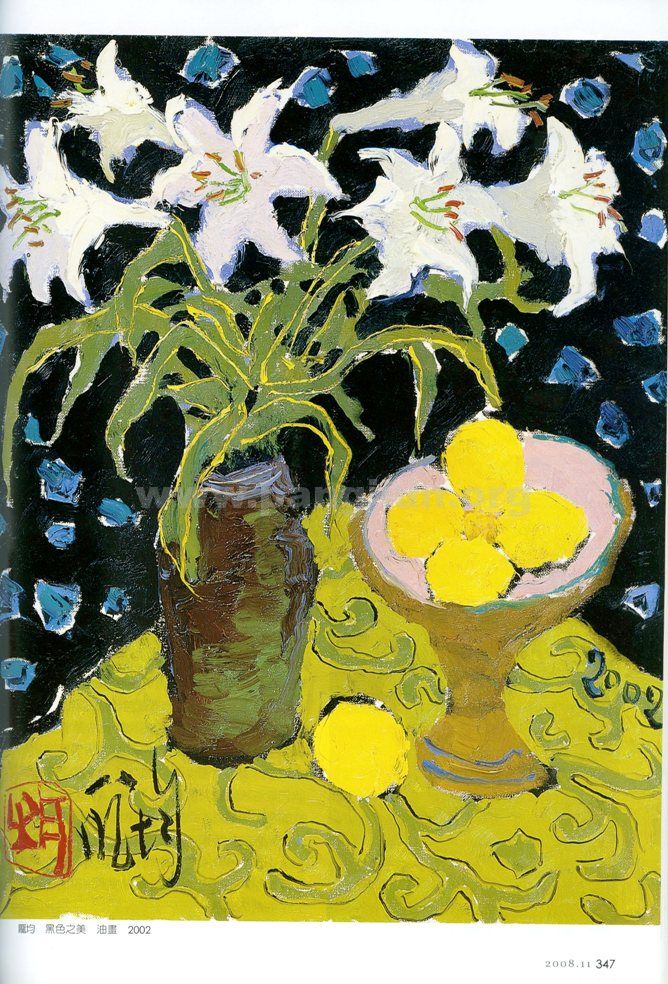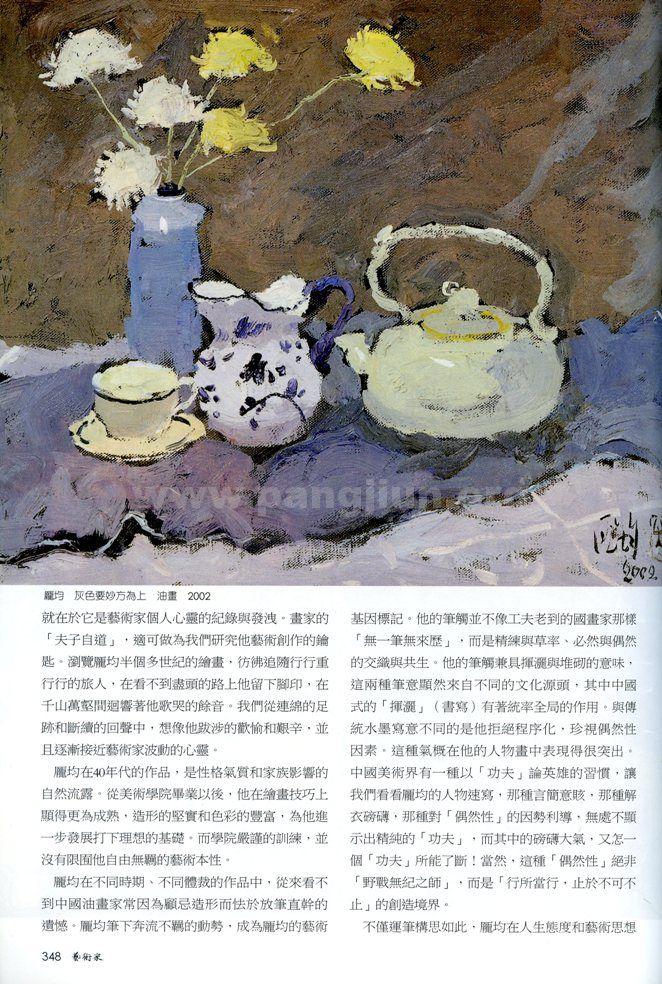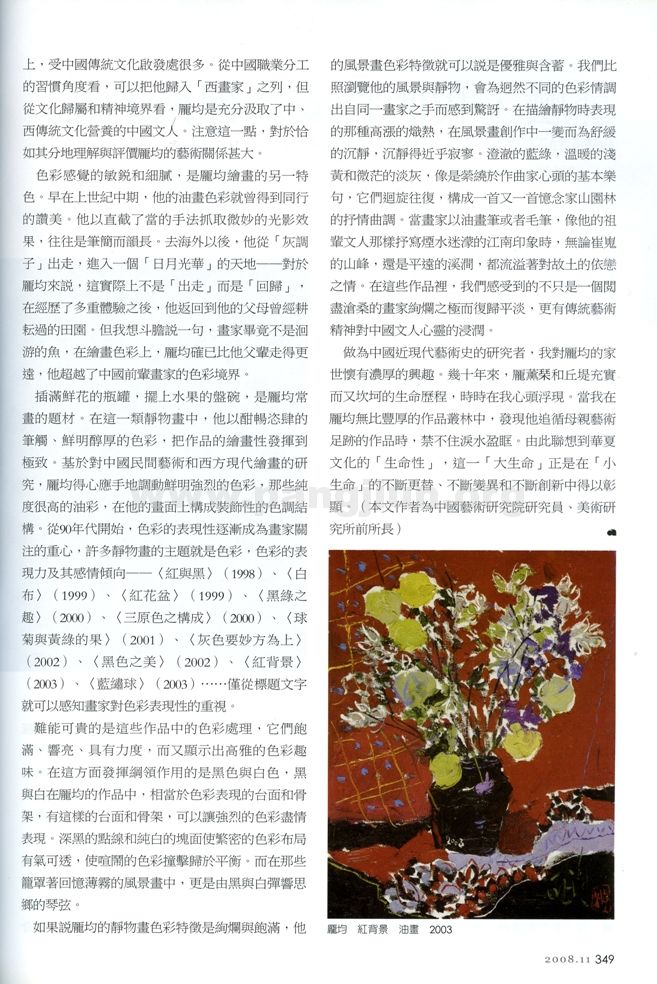 CLOSE
CLOSE
Pang Jiun is an artist who is used to thinking and has always pursued a very individualized form of creation. His father was Pang Xunqin, who played an important role in promoting the development of Chinese modern art, and his mother was Qi Di, an artist with an outstanding gift for art. Growing up in such a colorful and extremely open cultural environment, from early adolescence Pang Jiun obtained a high reputation for his sharp artistic perception amongst the artistic circle of his parents. During his childhood he drew portraits of his parents which were acknowledged as wonderfully natural. His watercolor paintings and sketches at primary school, such as Anti-Japanese Warrior and A Great River, showed evidence of a freeness and fluency. In the late 1940s, he and his sister Pang Dao held a dual art exhibition in Guangzhou and Shanghai, thus both stepping out onto the Chinese art stage. In the 1950s and 60s, their progress in art continued to gain attention within the art field and their works often received praise from colleagues from both abroad and at home. During the time that pan-politicalization prevailed within the artistic field, Pang Jiun’s clean and elegant realistic oil-paintings made an unforgettable impression on people upon first sight.
In 1980, Pang Jiun moved to Hong Kong and later to Taiwan. Amongst the new artists from mainland China, Pang Jiun was unknown. In the wide cultural and artistic exchanges of recent years, the artistic field of mainland China began to re-recognize Pang Jiun; especially in recent years, the exhibition and exchange activities held in places such as Beijing, Hangzhou and Shanghai allowed people another experience of stunning surprise. There’s usually much sentiment when old friends reunite after years of separation and after many experiences, however, the paintings and artistic works Pang Jiun brings to us reveal a wide and bright vision. No matter whether in his old works or in his latest ones, though his art and his theories, people can feel his creative energy and his thoughts about history.
The environment an artist grows up in, the cultural background and life’s experiences determine the artistic concept of an artist. Pang Jiun thinks that the reason art has the value of vitality lies in that it is the record and abreaction of the personal emotions of the artist. The artist’s typical principle of self-affirmation could be the key for us to his artistic creation. Looking through the paintings of Pang Jiun for over half a century, it seems we’re tracking a nonstop tourist leaving his footprints on an endless road and whose voice lingers on his journey. From his continuous footprints and intermittent echo, we can imagine his pleasure and hardship during his journey and gradually get close to the restless heart of the artist.
Pang Jiun’s works in the 1940s are the natural revelation of his personality and his family influence. After graduation from the art academy, Pang Jiun had more mature painting skills. The solid model and rich colors laid an ideal foundation for his further development and the strict training at college didn’t restrain his free and unconstrained artistic character.
From Pang Jiun’s works in different times and in different styles, unlike many Chinese oil painters, we can see that in form he never compromised on artistic freedom. The unconstrained and flowing momentum in Pang Jiun’s works becomes his artistic gene mark. His strokes are the interweaving and coexistence of refinement and carelessness, necessity and contingency other than those with necessary origins of experienced traditional Chinese painters. The two liberal styles of free exertion and piling shown in his strokes obviously come from different cultural sources in which Chinese-style writing/drawing plays the leading role of the overall pattern. Different from traditional Chinese brush drawing, he refuses stylization and weighs on occasional factors. This character in his portraits is given prominence. There is a convention in domestic art fields that skills make a great artist. Let’s have a look at Pang Jiun’s portrait sketches. The conciseness, power and smart introduction of contingency in his works all show his excellent and precise skills in which the power asks for more than skills. Of course, such contingency never means disorder but refers to a creation realm right to the point.
Besides such smart thinking and creation, Pang Jiun is significantly enlightened by Chinese traditional culture in his attitude towards life and artistic thought. From the convention of domestic professional divisions, he could be classified as an oil painter, but from the cultural attribute and spiritual realm, Pang Jiun is a Chinese artist who fully absorbs nutrients from both traditional Chinese and western culture. To realize this point helps a lot to understand and evaluate Pang Jiun’s art right to the point.
The sharp and subtle perception for color is another feature in Pang Jiun’s paintings. As early as in the middle of last century, the color in his oil paintings received praise from colleagues. He took advantage of a straight technique to grab the subtle shadow and light effects usually with simple strokes to express more. After going abroad, he walked out of a grey tune into a shining world which to him was not deviation but regression. Having experienced so much he returned to where his parents once struggled. But I dare say the artist is after all not a migrating fish. In terms of painting color, Pang Jiun walks even farther than his parents and even transcends the color realm of his Chinese predecessors.
Vases full of flowers, bowls with fruit are the common subjects in Pang Jiun’s paintings. In such still life paintings he uses fluent and free strokes, bright and heavy colors to exert the drawing nature of his works to the extreme. Based on research on Chinese folk art and western modern painting, Pang Jiun proficiently uses bright and intense colors and those oil colors of high purity to form the decorative color structure in his works. Since the 1990s, artists began to focus on the expressive force of colors, thus the theme of many still life drawings was color, its expressive force as well as its emotional tendency, such as Red and Black 1998, White Cloth 1999, Red Flowerpot 1999, Fun of Dark Green 2000, Composition of Tri-primary Colors 2000, Grey Priority 2002, Beauty of Black 2002, Red Background 2003 and Blue Hydrangea 2003 etc. of which from the titles we can recognize the emphasis by the artist on color expression.
What is important is the color treatment in these works which is replete, bright and powerful and also shows elegant color quality in which black and white play the leading role. The black and white in Pang Jiun’s works is equivalent to the platform and structure of color expression, which can express the intense color to the most. Dark black points and lines and purely white planes and sections make the thick and complex color pattern look vivid, and balances the dazzling color strikes. In those landscape paintings, the black and white strike the chord of homesickness.
If the color of Pang Jiun’s still life paintings is characterized by floweriness and fullness, the color in his landscape paintings is characterized by elegance and implication. When we compare his landscapes with his still lifes, we feel surprised that such distinctly different color tunes come from the same artist, which is expressed by high intenseness in depicting his still lifes and peaceful calmness, even close to solitude, in his landscape paintings. The clean blue green, warm light yellow and minor light grey, seem like basic movements lingering in the mind of a song writer. They repeat and whirl forming lyrical songs of homesickness. When an artist uses brushes or oil pens to describe the mild and misty impressions of southern China, like his predecessors, no matter whether depicting the high mountains or long rivers, out pours his love of his homeland. In these works we not only perceive the change of an artist from high prosperity to peace who has experienced so much but also the influence of the traditional artistic spirit of Chinese artists.
As a researcher on Chinese modern art history, I am so interested in Pang Jiun’s family background. For several decades, the substantial and unsmooth life course of Mr. Pang Xunqin and Mrs. Qiu Di always appears in my mind. When I discover in Pang Jiun’s extremely generous works that he follows the artistic footprints of his mother, I couldn’t help shedding tears thinking about the vitality of Chinese culture. It is the constant alternation, variation and innovation of tributaries that showcases the great source.
Shui Tianzhong – Researcher with the China Art Research Academy and former Director of the Fine Art Faculty of the China Art Research Academy



